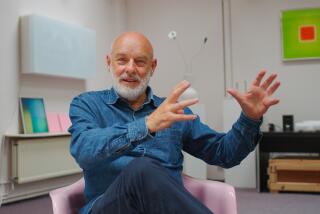Critic’s Notebook: Twisting a tune to suit you, the listener
A few weeks ago during his concert at the El Rey Theatre, young R&B singer Frank Ocean stood alone in front of a mike onstage while a big image of a solar eclipse shone behind him. He was in the middle of his “American Wedding,” which isn’t really his song per se but him crooning new lyrics over the music of the Eagles’ classic L.A. snapshot “Hotel California.”
He moved through his updated verses, a wonderful yarn about marriage and divorce, as the moon passed across the sun behind him and the song made its way toward that epic Don Felder and Joe Walsh tag-team guitar solo. And when it arrived, the image on the screen cut to the video game Guitar Hero, where an avatar band also was jamming on “Hotel California.” Ocean grabbed a toy guitar from a roadie, turned to face the game, struck a pose and played along, nailing each note while twisting his body like Jimi Hendrix. (He ended up with 350,000 points.)
It was a striking, witty move, one that acknowledged the karaoke-esque nature of his (unlicensed) appropriation. But at the same time, Ocean was, intentionally or not, implicitly messing with the distinction between performer and fan, a line that’s becoming increasingly blurred as speedy computer processors enable gaming systems, smart phones and iPads the ability to generate new ways not only to digest music but also to interact with it: fans as active participants in the evolution of artistic ideas — social creativity.
Guitar Hero is old news by now, but in its wake have arrived ever more sophisticated and intuitive applications that point toward a grand shift in how we absorb, play — and increasingly play with — music. A few of the hundreds of music-related apps (excluding those that act as instruments, which is a whole other realm of wonder) suggest the breadth of the offerings, some borderline visionary, some playful, others silly. They range from full-length album re-imaginings to digital DJ tools that open the entire recorded library to cut-and-paste, four- and eight-bar looping; from quirky single-song apps that offer time-killing games to karaoke challenges and music trivia quizzes.
The most visionary recent release is also the most acclaimed: Icelandic experimental chanteuse Björk’s “Biophilia” iPad album, which features a different app for each of the songs and cracks them open one by one to shed light into her music and art by allowing listeners active roles in examining them. The app for the song “Solstice,” for example, is a total trip: She and her team of designers have basically created a new musical instrument on the iPad featuring orbiting sonic circles spinning in space that can be manipulated, tuned and played by increasing and decreasing the speed of the orbit, the tone of the note being played and the quantity of sounds.
It sounds way more complicated and way less beautiful than it is — as much a visual creation as an aural one. If you just want to hear the song, of course, you can do that; if you’re curious about reading the song’s written score, hit a button and the notation appears to accompany the music. But if you want to dig into the nuts and bolts of the compositions and rework them, Björk’s work enables it.
Best, the “Solstice” app, as with the others on “Biophilia,” allows users to record the music they make, save it, share it with friends and, in the process, better understand the ways in which Björk’s voice and music can be re-imagined from within. Perhaps most telling, though, is how much better the apps and the visual representations of the music have been received than the music-only compact disc release. Musically, “Biophilia” found Björk stuck in the same stylistic rut she’s been in for the last few releases, making typically atypical experimental electronic music. Compared with the visual feast of the interactive release, the static version of “Biophilia” seems stunted.
This truth, in fact, reveals a danger of combining high-tech visual programming with music: Experiencing a song as a singular sensual moment, getting lost inside your head — getting lost in music — is a sublime feeling, one that necessitates blocking out the other four senses. What gets lost by combining organized sound with organized interactivity?
It depends on the product (and let’s face it, this new world is as much about monetization as it is art). Little suffers in the translation to Sir Mix A Lot’s Baby Got Back, the Seattle rapper’s new iPhone app, which gives you not only the ode to booty to play whenever you want but also a hilariously bawdy photo-editing tool called Mix’s Makeover that enables you to expand the derriere of any lover, friend or foe in your photo library to bubble-tastic proportions.
Feel like jamming AC/DC but also want to play pinball? Sony offers a virtual machine that rocks the Australian rock band’s songs while you play pinball on a table with as much action and immediacy as a tabletop version. If AC/DC’s not hard enough for you, the machine is also available in a Slayer version.
Sony has also started releasing an Open Mic series of karaoke-style games featuring, among others, the tunes of Alicia Keys, Kelly Clarkson and David Archuleta that allow fans to sing along with their favorite artists and score points for hitting notes. These games, however, don’t allow you to open up the music and futz around with it. They’re passive musical experiences more akin to video game soundtracks than interactive musical experiences.
For futzing and for learning how to be a superstar DJ, the two-turntables-and-a-mixer app Djay, made by German company Algoriddim, transforms the mechanics of DJing — mixing, beat-matching, sampling, scratching, looping — into skills that can be mastered in an afternoon rather than a year and opens up a world in which songs can be carved, mixed and matched together on the fly to create new combinations.
Think that’s a not a big deal? Until recently, to play music at a club or a backyard party, you needed two heavy turntables, a mixer and if using a computer, an interface — not to mention crates of records and/or CDs and a trunk big enough to fit all of it in. Now all you need are an iPhone/iPad, your digital library, an amplifier, a few rudimentary skills and good taste.
The first time I got my two Technics turntables and mixer at the end of the 1990s and tried to beat match — the act of locking the beats of two songs into a single rhythmic groove as a way to transition into and out of songs (and keep the party poppin’) — I pulled out Hank Williams’ “Greatest Hits” and the Chemical Brothers’ “Exit Planet Dust” and tried locking various tracks from each together to create a primitive mash-up. And tried and tried, failing miserably to not only distinguish between the songs’ different rhythms simultaneously but also to get them at the same speed at the same time.
That same experiment took about five minutes of fiddling to create on Djay (long enough to determine that a Hank and Chemical Brothers’ mash-up wasn’t a very good idea). What was way more fun, though, was creating on-the-fly remixes. Curious how one of drummer Dale Crover’s monstrous Melvins breakbeats would sound paired with the Wu-Tang Clan’s “Gravel Pit”? Find a groovy Crover rhythm, loop four bars of it, sync it up with the Wu-Tang track and bingo, instant mash-up.
Other than to offer yet another pleasant diversion while you’re waiting in line for a Pink’s hot dog and snapping pictures of butts to perform a Mix Makeover on, how does this world of interactivity change the art of listening?
It’s too soon to tell, but assuming that creative technologists and musicians continue to brainstorm new methods of untethering notes, melodies, verses and rhythms from their foundations and using them not only as music to appreciate but also as tools for sonic construction, the act of homage will continue to converge with montage and assemblage, and from them will spawn … whatever it is that’s next on the horizon.
More to Read
The biggest entertainment stories
Get our big stories about Hollywood, film, television, music, arts, culture and more right in your inbox as soon as they publish.
You may occasionally receive promotional content from the Los Angeles Times.






